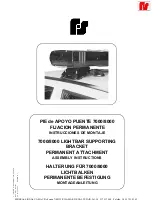
Catalog #70080, #70081, #70082, #70083
Brochure No. 63-0312
©2008 Edelbrock Corporation
Rev. 07/08
Page 15
2.8
2-Stage Solenoid Mounting Information
When mounting your solenoids in a 2-stage configuration, special attention must be paid to your system set-up. Be sure
that you utilize the Performer RPM solenoids for your first stage, and the Victor Pro solenoids for your second stage. The
Performer RPM solenoids may not be capable of the flow rates required by the high horsepower levels of the second stage.
Please refer to the 2-stage wiring diagram to determine proper solenoid connections.
2.9
Nitrous/Fuel Solenoid Disassembly and Inspection
1. Close the valve on the nitrous bottle.
2. Empty the main nitrous supply line.
3. Remove the solenoid from the engine and securely clamp it to a vise, taking great care not to damage the solenoid.
4. Remove the solenoid cover retaining nut from the top of the solenoid.
5. Remove the coil and housing from the solenoid base.
6. Unscrew the stem from the solenoid base. Do this by using a solenoid stem removal tool or by “double nutting” the
stem and unscrewing the stem from the housing body.
Do not
use pliers on the solenoid stem; damage to the stem
will result.
7. Remove the stem, spring and plunger from the solenoid base paying close attention to the way they are assembled.
8. Examine the plunger seal for swelling, cuts and abrasions. The seal surface should be flat, except for a small circular
indentation in the center of the seal.
Note:
A seal that has been contaminated or over-pressurized will bulge from exposure to chemicals other than fuel
or nitrous oxide. It can appear to extend down from the plunger and be dome-shaped. A contaminated seal may
return to its original shape if left out in fresh air for approximately 48 hours. It may then be returned to service. If it
does not return to its original shape, it must be replaced.
9. Clean the solenoid body.
Do not use an oil-based solvent
to clean any part of the solenoid. Remove all foreign
matter and dirt. Make sure solenoid body is clean, dry and free of oils before assembly.
10. Replace the O-ring, plunger and piston spring.
11. Re-assemble the solenoid by reversing the disassembly procedure.
















































